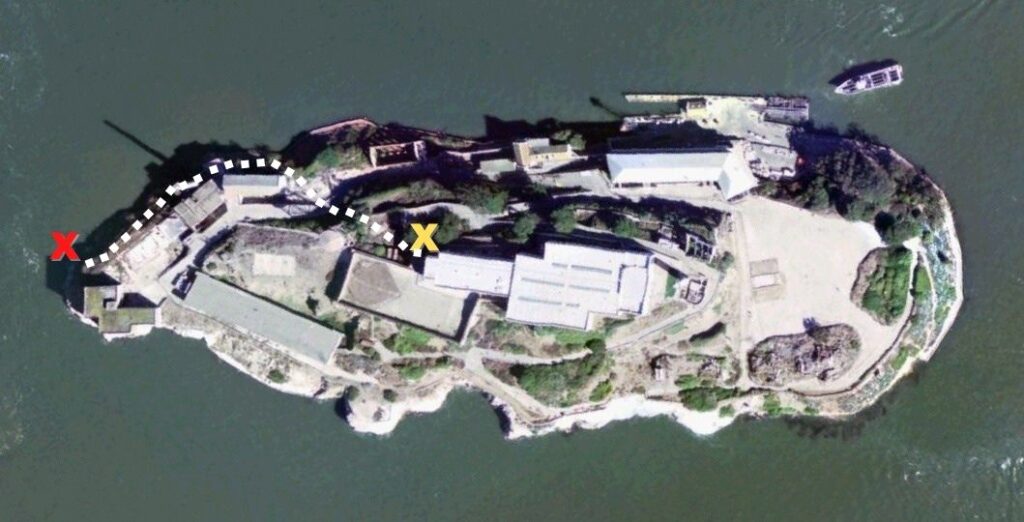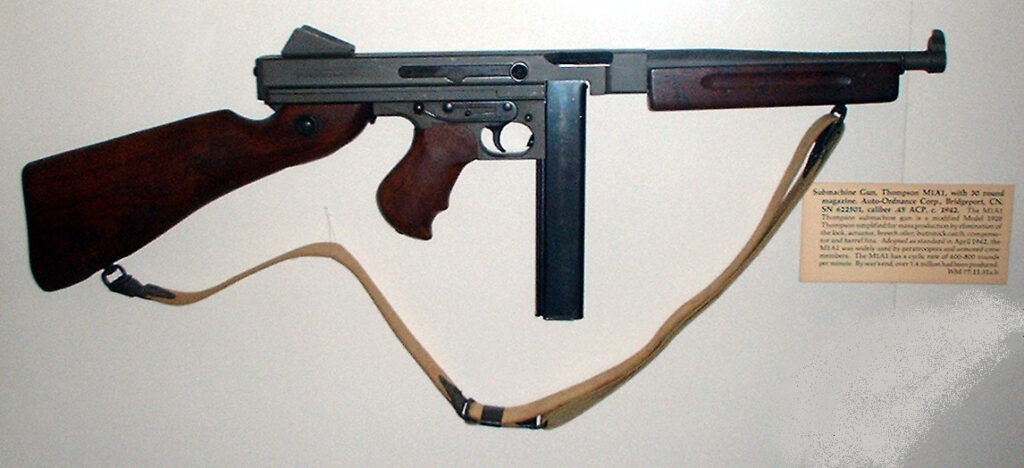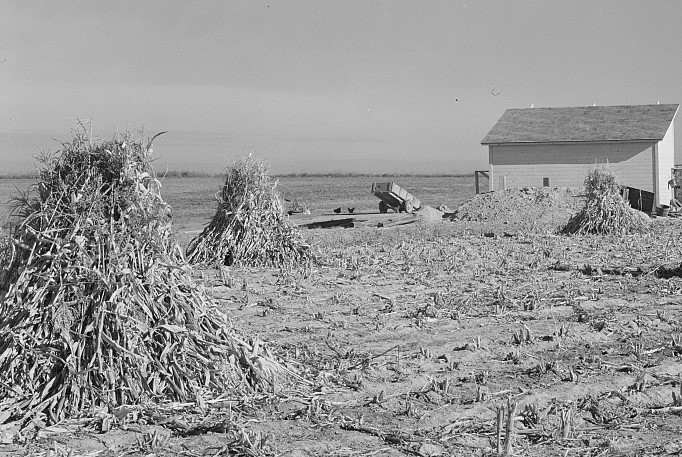A disastrous break-in and shoot-out in a small town leads to a daring escape attempt from “The Rock.”
John “Paul” Scott shocked prison authorities and perhaps the entire world on Sunday, December 16, 1962, when he became as Rich Jordan writing for the San Francisco Examiner put it “the only man known for certain to have made it from the Rock to the mainland alive since it became a Federal prison.” He was serving 30 years for attempting to burglarize the Farmers & Traders Bank of Campton, KY, in January 1957.
Scott escaped from the maximum-security Federal Penitentiary on San Francisco Bay’s Alcatraz Island under cover of rain and mist and swam and floated about three miles through the 54℉ (12℃) water to the San Francisco mainland using makeshift water wings consisting of a denim prison shirt in which he had knotted the sleeves closed and stuffed with several pairs of inflated and tied-off surgical gloves for buoyancy.
He was found semiconscious, shivering, and naked except for his socks, lying just above the surf line on the rocks near Fort Point, under the Golden Gate bridge. Some teenagers had spotted him and called authorities to report a dead body. Military police from the Presidio took Scott to Letterman Hospital where he was treated for exposure. His body temperature had dropped to 94℉ (34℃) putting him in a state of mild hypothermia.
Scott’s Alcatraz escape partner, Darl Dee Parker (sometimes identified as Darl Lee Parker), only made it about 100 yards to Little Alcatraz, a small rock northwest of the island. He was spotted there by guards from the prison launch about 20 minutes after the men were reported missing at 5:47 pm, after a routine headcount. Parker was serving a 50-year sentence for an Ft. Wayne, IN, bank robbery, shooting his way out of a county jail, and kidnapping a postal worker.

Scott and Parker made their initial escape from the culinary unit beneath the kitchen at the northeast end of the main cell house. They had sawed through a bar in a window and a vertical steel spreader. Warden Olin D. Blackwell theorized that the pair had used a guitar or violin string coated with an abrasive household cleaner to cut through the bars over a long period of time. As part of the kitchen crew, they had frequent access to the basement room.
The San Francisco Examiner quoted Scott as saying “It would have been alright if I could have made it,” as Alcatraz guards rolled him in a gurney onto the prison launch at 10:35 pm that same night.
I could find no firsthand account or interview with Scott about his two-hour-plus trip across San Francisco Bay but it must have been terrifying. He had so much to contend with, the growing numbing cold, doubts about his hastily fabricated flotation device, fear of being spotted by the Coast Guard and prison boats he knew would be searching the bay for him, and fear of sharks.
The currents that deposited him at Fort Point could have just as easily slammed him mercilessly onto rocks, pounding him senseless, carried him out into the Pacific where he would have died from hypothermia and drowned. It wasn’t the first time Scott found himself freezing and lucky to be alive. The desperate beginning of his journey to Alcatraz oddly mirrored his attempted escape from it. Scott’s criminal history appeared designed to get him lodged in federal prison in general if not Alcatraz in particular. It might be fair to say that Paul Scott never met a bad idea that he didn’t like.

Safecracking, Speeding, and Resisting Arrest
On the night of Sunday, December 3, 1950, Paul and his brother, Donald R. Scott, broke into the main Post Exchange (PX) at Sheppard Air Force base near Wichita Falls, TX. After gaining entry by breaking a hasp on the East door, they blew open a four-foot high safe and damaged a smaller safe but were not able to open it. Among the debris and concrete dust littering the floor of the exchange, investigators found watch boxes, rolls of coins, a crowbar, a wrapper from a bar of laundry soap, a burned fuse, an unused fuse and blasting cap, and a bottle of liquid which when analyzed turned out to be nitroglycerin.
The brothers were stopped for speeding in Sherman, Texas about 120 miles from Sheppard AFB at 2:30 am the following day. Policemen became suspicious when they spotted two .45 caliber handguns on the front seat of the car, and five money bags in the back seat. One of the bags had new watches spilling out of it. There was also a brown suitcase that contained $8,551.16 in cash.
They were taken to the Sherman Police Station and while being searched one of the brothers grabbed a .38 caliber revolver from Officer Henry Fagan’s holster, shouted “Don’t nobody move,” and fired three shots. The other brother lunged for the two .45 caliber pistols that had been confiscated during their arrest but was unable to reach them. Officers returned fire and multiple newspaper reports say at least 15 shots were exchanged inside the station. The only injuries were a scalp wound to one of the brothers and a cracked rib received by Patrolman Johnnie Gorman who one of the brothers kicked during the scuffle. The Scotts were found guilty of the PX burglary and three counts of assault with intent to murder and served five years in the Texas State Penitentiary at Huntsville.
Bungled Burglary
While serving time in Texas, the brothers met Earl Franklin Morris of Ponca City, OK, who traveled to Kentucky to assist them in what would become their masterpiece of criminal incompetence.
On Monday, December 16, 1956, the trio broke into the Danville, KY, National Guard Armory and stole two .45 caliber Thompson submachine guns, three .30 caliber carbines, and an unknown amount of ammunition.
At about 9 pm on Saturday evening, January 5, 1957, Fayette County, KY, Patrol Sgt. James Pelfrey and Patrolman Everett Crace approached a parked car to ask if the motorists were having difficulties. While they engaged a man in conversation another man emerged from the car with a Thompson submachine gun and threatened them. The cops retreated to their cruiser, and the man fired a 10-shot burst over their heads. Pelfrey and Crace immediately put out an all-points bulletin (APB) for the car, and later they would positively identify Paul Scott as the shooter.
A little geographic context, Paul Scott resided in Leitchfield, KY, approximately 180 miles away from Campton. Don Scott lived around 110 miles from Campton in Liberty. At the midway point of their criminal road trip, they fired a submachine gun at two police officers hours before breaking into a bank, not exactly flying under the radar.
On Sunday, January 6, around 1:00 am, the three burglars pulled up behind the Campton Farmers and Traders Bank. They unloaded an acetylene torch, the tanks that went with it and various other tools of their trade including a five-gallon can of sand, a burlap sack full of burlap sacks, a crowbar, pickax, and .45 caliber magazines for the Thompsons.
Paul gained entry to the building by removing a grate from a restroom window and breaking the glass. As he slowly opened the restroom door, the bank’s night watchman, Dan B. Stone shot him twice with his 9mm P-38 automatic. A little over a year prior, the bank had been broken into and in response had hired the 22-year-old, former paratrooper to sleep on a cot in the back of the bank and keep an eye on things. Scott fell to the floor groaning wounded in the mouth and right arm. Stone left the bank and ran to a hotel on Main Street where he phoned Sheriff George D. Little to report the break-in.
Submachine Gun Shootout
Sheriff Little arrived on the scene with two deputies, and they and Stone, who was barefoot, wearing underwear and a coat, surrounded the bank. A man darted out of an alley, across Main Street and down Johnson Street. Stone and Little chased him, rounded the corner, and ran straight into a stream of .45 caliber slugs from one of the submachine guns. Little was hit in both legs and went down. Stone fired at the shooter until he was out of ammo. He ran to the Sheriff’s side and asked for his gun but Little had lost the weapon when he was hit. Stone looked up and saw one of the burglars slam the butt of one of the Thompsons into his head. He went down, tried to rise, and was clubbed again. The sheriff’s deputies ran up and the burglars escaped in their car.

Little was taken to Good Samaritan Hospital in Lexington with bullet wounds to both knees. The injuries ended his law enforcement career. A subsequent newspaper article said the .45 caliber bullets shattered his foot, leg, and knee. He required numerous operations but was able to walk again with crutches.
The getaway car, a green 1952 Chrysler was found abandoned with a shredded rear tire and a bullet hole in the trunk about five miles out of town. Additional burglary tools and supplies were discovered inside the car. It was basically a hardware store on wheels.
On the morning of Monday, January 7, Don was arrested at a farmhouse a few miles out of town where he had sought shelter overnight to avoid freezing. The homeowners had reluctantly allowed him to spend the night on their sofa and fed him breakfast. Shortly after that police, acting on a tip, surrounded the home. Don came out. He was unarmed and offered no resistance.
Getting Schooled
Around 6:00 am the same morning, Wolfe County school superintendent, Taylor Booth saw a stranger near the local high school. He decided to investigate and found an armed man hiding in one of the school buses. It was Morris. According to Booth’s account, Morris considered taking him as a hostage but he was able to talk Morris into taking the car and leaving him behind at the school. Morris had Booth turn his back while he transferred Paul from the bus into the car. The less he saw the better. Booth, however, clearly heard Paul’s groans and bloody clothing was found in the bus.
At about 8:30 am Tuesday, January 8, Booth’s car was found abandoned about seven miles from town. A posse made up of nine FBI agents, 10 State Troopers and local officers and some deputized civilians fanned out and searched the surrounding area. They encountered Harold Alexander, a farmer, who thought he had seen something move under one of his fodder shocks in his neighbor’s cornfield.
They surrounded the shock of fodder and an unnamed FBI agent is reported to have shouted “Come out peacefully, if you know what’s good for you.” Paul Scott crawled out. He was obviously in bad shape and initially unable to speak. The agent called out again, received no answer and some of the group kicked over the fodder shock and discovered Morris under the corn stalks. Both of his feet were frostbitten, and he was unable to walk. The men were taken to a clinic in Campton and then to the same Lexington hospital as Sheriff Little.

They also recovered one of the submachine guns, an extra clip for it, and two revolvers: one .38 and one .22 caliber.
According to the Lexington Herald, Commonwealth Attorney Douglas Graham said Paul Scott admitted to breaking into the same bank in December 1955 and that in addition, Morris told Graham that the brothers had also told him about the burglary. Clearly, the Scott brothers had gone to that well once too often.
One Escape Attempt Too Many
Paul Scott completed his journey to Alcatraz by attempting to escape from the hospital minor surgery room at Atlanta Federal Penitentiary along with three other prisoners on November 24, 1958. The men sawed through bars on a window and climbed onto the cell house roof. They evaded guards for about an hour but it wasn’t a very well-thought-out escape attempt.
On March 21, 1963, Alcatraz was closed after 29 years of operation (1934-1963). The Bureau of Prisons decided that the island prison was too expensive to operate. Paul Scott was moved to Leavenworth Penitentiary in northeast Kansas, and then to a prison in Marion, Illinois, where he attempted another breakout. He died in Florida’s Federal Correctional Institution in Tallahassee in 1987.
If you enjoyed this post, please consider sharing it with a friend. Click on one of the social sharing icons below. Do you have a hot tip on a cold case? Got a topic you’d like to see covered? Want to nominate a moonshine king, Appalachian outlaw, legendary lawman, massive manhunt, or blue-ribbon bloodhound for a future post? Clue me in with an email to editor@blueridgetruecrime.com.
Check out my new book, Blood on the Blue Ridge: Historic Appalachian True Crime Stories 1808-2004, cowritten with my friend and veteran police officer, Scott Lunsford on Amazon. Buy it here! Download a free sample chapter here!
I also have a Substack newsletter, A History of Bad Ideas, where I write about poorly thought-out ideas, misguided inventions, and dire situations throughout history created by people who frankly should have known better.
Sources:
Alcatraz Escape
Atlanta Constitution, Tuesday, November 25, 1958
Oakland Tribune Monday 17 Dec 1962, Page 1 & 3
San Francisco Examiner Monday, Dec 17, 1962 Page 1 & 7
Capital Journal (Salem, Oregon) Friday, Apr 13, 1979 Page 21
https://en.wikipedia.org/wiki/List_of_Alcatraz_escape_attempts
Kentucky Bank Burglary & Shootout
Lexington (KY) Herald Monday 7 Jan 1957, Page 1 & 8; Wednesday, January 09, 1957; Friday 1 Feb 1957 Page 1
Courier-Journal (Louisville) Tuesday 8 Jan 1957, Page 1; Wednesday 9 Jan 1957, Page 1 & 16
Paducah Sun (KY) Wednesday 9 Jan 1957 Page 12
Messenger-Inquirer (Owensboro, KY) Wednesday, January 9, 1957
Park City Daily News (Bowling Green) Wednesday, January 9, 1957
Sheppard AFB PX Burglary
Wichita Falls Times (Texas) Monday, December 04, 1950 Page 1
Fort Worth Star-Telegram Monday, December 04, 1950 Page 1
Times Record News (Wichita Falls, TX) Thursday, May 17, 1951 Page 2; Wednesday, May 16, 1951 Page 16


My 95 year old uncle recently told me what I believed to be a very tall tale about a man who robbed a bank in nearby Campton, KY and was eventually sent to Alcatraz only to actually escape. I chalked it off to dementia. Boy, was I wrong. I will share this article with him. Thanks!
Thanks for the comment. John “Paul” Scott took a long windng road to Alcatraz. He never met a bad idea that he didn’t like.